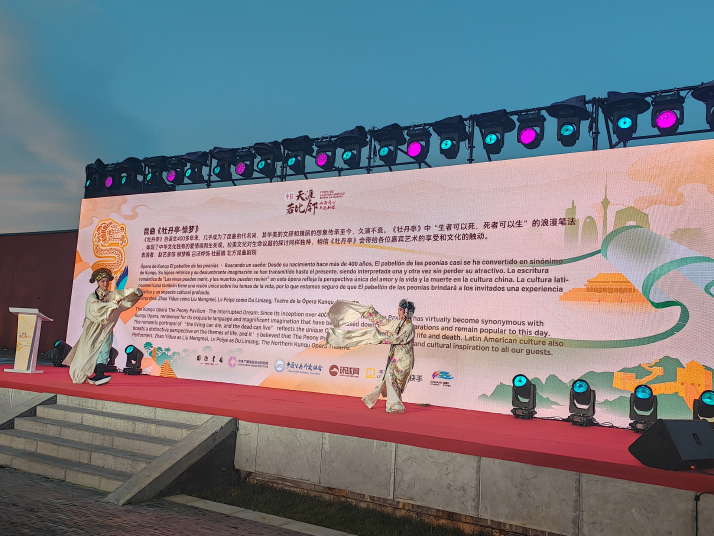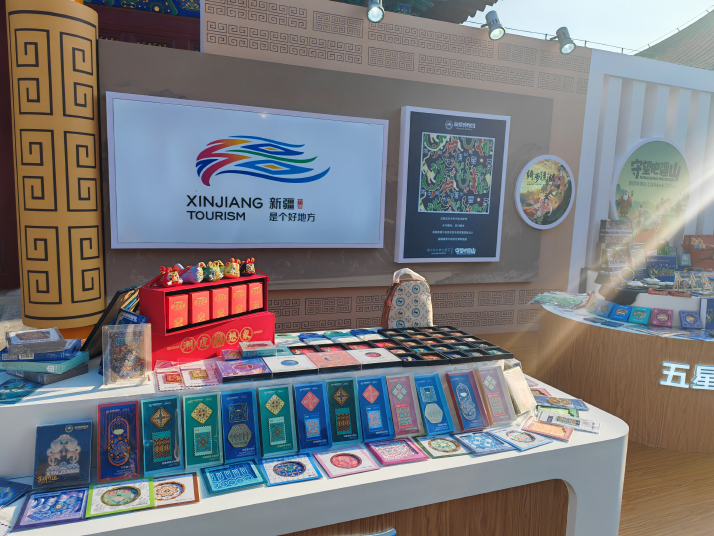| China |
| We-media workshop reshapes LAC influencers' perceptions of China | |
|
|
 A Kunqu Opera performance takes to the stage during the closing ceremony of the second training workshop for We-media influencers from Latin American and Caribbean countries in Beijing on September 13 (ZHANG YAGE)
The Mid-Autumn Festival, celebrated on the 15th day of the eighth month in the Chinese lunisolar calendar, is a time for family and friends to reunite. As a famous Chinese poem goes, "The moon rises over the sea; we share this moment no matter how far apart we are." Since ancient times, people in China have gathered under the bright, full moon to enjoy mooncakes together, while those far away would gaze at the same moon, wishing for future reunions.
On September 13, four days before this year's Mid-Autumn Festival, a group of journalists, diplomats, international students and influencers gathered in Beijing to celebrate the conclusion of the second training workshop for we-media influencers from Latin American and Caribbean (LAC) countries. Hosted by the China Public Diplomacy Association (CPDA), the annual workshop aims to facilitate friendship between participants and enhance mutual understanding between China and LAC countries. This year, it opened on August 31 and invited 19 influencers from 23 LAC countries to tour China, visiting places including Beijing, Hunan, Fujian, Guangdong and Shandong provinces, as well as Xinjiang Uygur Autonomous Region. "The geographical distance between China and LAC countries creates a natural barrier to mutual understanding. It's difficult for people in LAC countries to see the real, fast-developing China objectively, especially the country's current transformation," said Wang Donghua, Vice President of the CPDA, at the closing ceremony. "It's in the long-term interests of both China and LAC countries to deepen mutual understanding, which forms the foundation for our cooperation on all fronts." Wang also addressed how Western media narratives have perpetuated stereotypes and misconceptions about China. However, with growing exchanges and efforts from influencers who have visited China, these misconceptions are fading. Quoting Latin American scholar Pedro Henríquez Ureña, Wang emphasized the need for both China and LAC countries to "seek our expression" and share their civilizations and true stories with the world. New impressions The workshop participants were selected from a group of influencers who had contributed to the China-LAC: Close Friendship Obliterates the Distance short video contest. Co-hosted by the CPDA, online news portal Huanqiu and leading short video and e-commerce platform Kuaishou (known internationally as Kwai), the contest inspired participants from LAC countries to create videos related to China. These videos went on to garner global attention, raking in 200 million views on international short video platforms, with the most popular one having been viewed 30 million times at the time of writing. "Watching these videos was a visual feast for us. They serve not only as windows into the rich tapestry of Chinese culture, but also as bridges spanning continents," Shan Chengbiao, General Manager of Huanqiu, remarked at the closing ceremony. He specifically noted the video by Trinidad and Tobago influencer Josha Regrello, in which Regrello played the traditional Chinese melody Jasmine Flower on a steelpan drum, a traditional instrument from his home country, on a section of the Great Wall. The performance was widely praised by LAC netizens as "infectious" and "innovative." "I believe both the contest and the workshop provide great opportunities to promote mutual understanding and cultural exchange between China and LAC countries. Personally, I'm deeply impressed by China's long history, festivals, strong sense of community and family values, and the integration of different ethnic groups," said Marco Sander, an influencer from Paraguay. "I realized that people in my country know very little about China, and as content creators, we have a responsibility to use social media platforms to foster understanding and cooperation between our peoples." The trip not only deepened participants' understanding of China's culture and society but also gave them the chance to connect with Chinese people. "The beautiful sights we've seen will remain etched in my memory. But what impressed us even more were the Chinese people we met," said Brazilian influencer Renan Jereissati at the ceremony. "I remember the hug from a Uygur woman after a concert, the warmth of a Uygur family who warmly welcomed us, like family members, into their home for dinner, and the kindness of hospital staff who gave us effective acupuncture treatments. I will always remember their support and care."  Cultural products from Xinjiang Uygur Autonomous Region on display at the closing ceremony of the second training workshop for we-media influencers from LAC countries in Beijing on September 13 (ZHANG YAGE)
Sharing moments As the final event of the influencers' journey, the closing ceremony featured activities and stalls packing traditional Chinese cultural elements. These included Kunqu and Peking opera performances, a Chinese tea ceremony, and cultural products from the Museum of Xinjiang, which the participants had visited during their tour of the region. To make traditional Chinese culture more accessible and understandable to international visitors, the stage performances included globally recognized artists from traditional Chinese dramas. They featured the Kunqu Opera piece The Peony Pavilion, which explores ancient philosophical views on love and life, and the Peking Opera piece Monkey King Wreaks Havoc in Heaven, inspired by the classic novel Journey to the West. Peking Opera titles starring the Monkey King as the protagonist, which showcase lively facial makeup and dynamic acrobatic movements, have been well received by overseas audiences during previous cultural exchange events. "I learned about all the different steps of the Chinese tea ceremony and even created one of the foil paintings," Nicaraguan influencer Carolyne Balmaceda told Beijing Review. She added that she is planning a special video series about hanfu, saying, "All of my followers are looking forward to seeing the videos about Chinese culture and costumes." Next to the hanfu stand was a makeup stall where visitors could experience huadian, a form of traditional Chinese facial decoration, literally meaning "floral ornamental emblems." Dating back to written records from the Tang Dynasty (618-907), huadian was popular nationwide hundreds of years ago. Classic designs include jasmine, cherry blossoms, lotus, peonies and plum blossoms, often painted in red, green and yellow pigments. Beyond showcasing age-old treasures, the ceremony also highlighted impressive modern technology. Kuaishou's automatic photography equipment featured a cutting-edge motion capture camera, capable of recognizing specific hand gestures to switch between camera effects. When people perform specific gestures, such as waving their hand, the camera automatically changes its effects, like applying filters, adjusting lighting or framing, without the need for manual adjustments. Attendees could have their photos taken, and printed, surrounded by a thematic frame from the event. "I took a picture with my Chinese and Latino friends using the Kuaishou camera—it's pretty simple and convenient. We chose the Peking Opera and panda effects," Daniela, a Colombian participant who preferred to go by her first name, told Beijing Review. "It's such a wonderful way to retain this event in my memory. I will keep the printed photo on my table as a reminder of the importance of communicating, sharing and understanding." (Print edition title: Mooncakes to Meaningful Connections) Copyedited by Elsbeth van Paridon Comments to zhangyage@cicgamericas.com |
|
||||||||||||||||||||||||||||
|